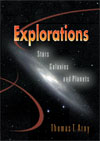Terrestrial planets, as their name suggests, have a size and structure similar
to Earth's. Within our Solar System, Mercury, Venus, Earth, and Mars fit in
this category. Orbiting in the inner part of the Solar System, close to the
Sun, these rocky worlds are too small and too warm to have captured massive
hydrogen envelopes such as those that cloak the outer planets. Nor have they
the array of moons possessed by their cold, giant brethren. In fact, of the
terrestrial planets, only Earth has a large moon, although Mars is orbited by
two tiny captured asteroids. |



 2002 McGraw-Hill Higher Education
2002 McGraw-Hill Higher Education